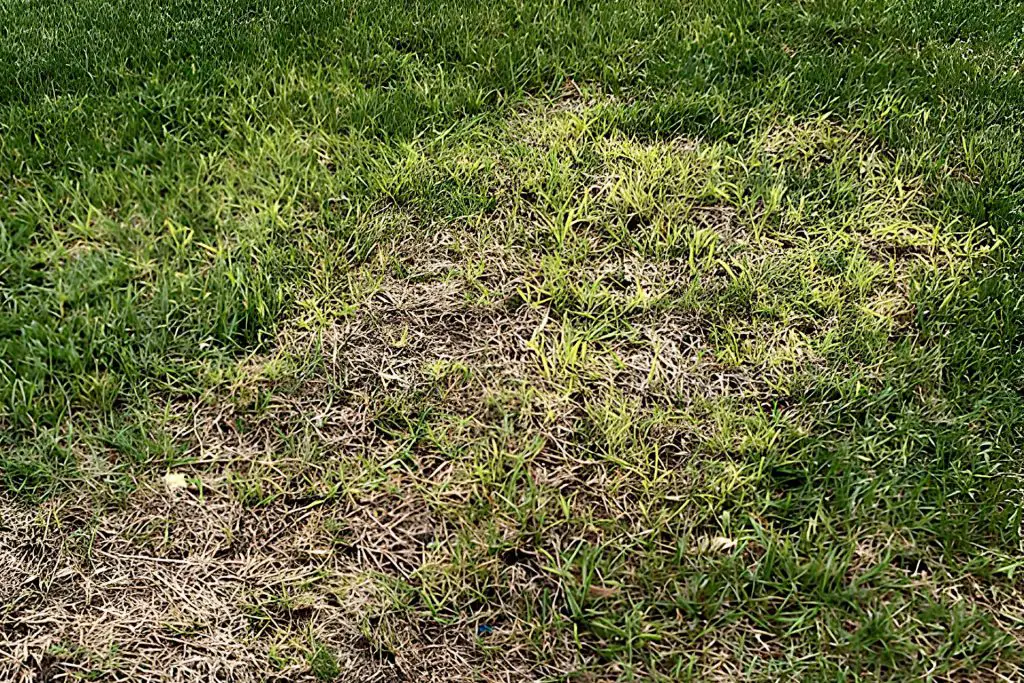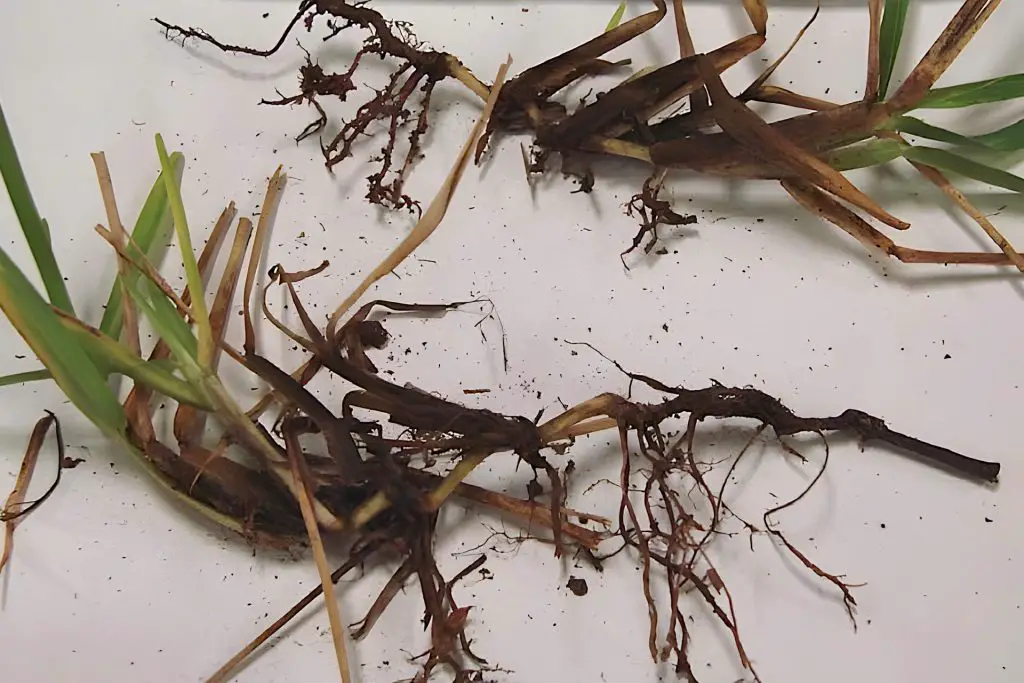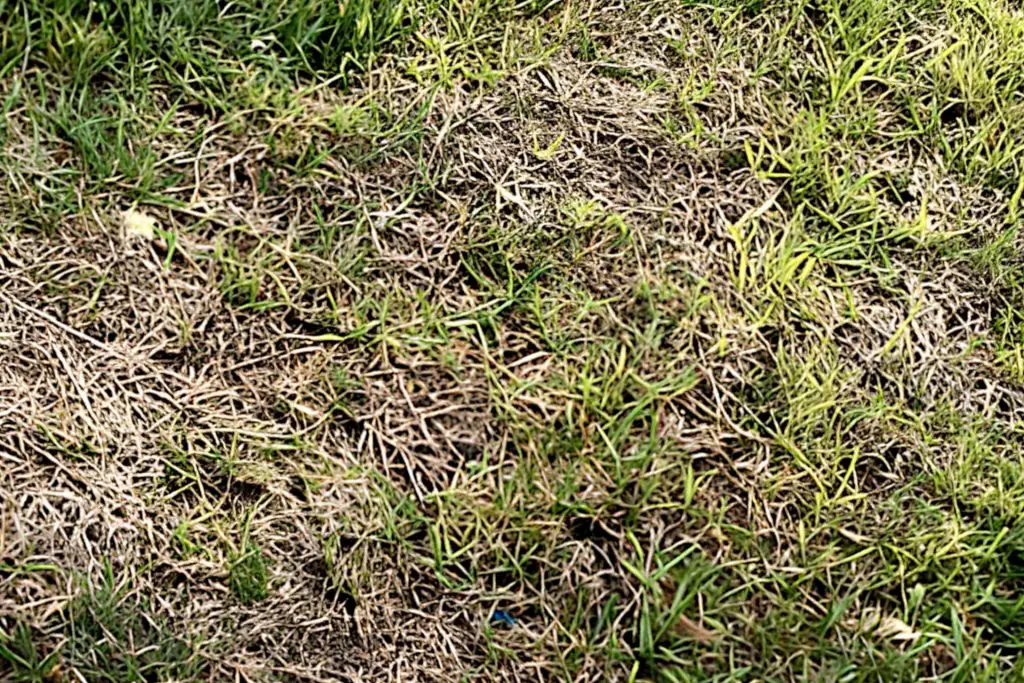Take-All Root Rot – How to Spot It, Treat It, and Prevent It from Occurring
Take-all root rot, also sometimes known as “bermudagrass decline”, is a soil-borne fungal disease caused by the Gaeumannomyces graminis var. graminis pathogen. The disease caused by this fungus attacks grass roots, causing them to rot, whither, and die.
The disease is especially problematic for warm-season turf grasses, grasses such as Zoysia, Bermuda grass, and St Augustine grass. The fungus inhabits the soil and can spread rapidly if not dealt with.
Although it is capable of producing spores that can be carried on the wind or through water, it more typically propagates through the plant’s roots and stolons instead. It does not normally spread through external agent transfer, such as equipment or foot traffic but more usually via grass clippings dead grass, or soil transfer.
Symptoms to Look For


The first signs of Take-all root rot are the development of yellow brown patches on the lawn, these patches will gradually increase in size and spread and turned dark brown. On close inspection, you will notice that the grass in the area has thinned and appears dead. If you pull up a patch of grass from the area you will see that the turf grass roots are grayish black and rotted.
These symptoms typically manifest themselves in the spring or the beginning of summer, shortly after the grass re-emerges from its dormant state.
Conditions Conducive for Take-All Root Rot
The disease is especially common in soils that are moist and poorly drained. It thrives in humid environmental conditions such as when heavy rain is followed by strong heat. Disease development can be amplified where a grass area has a thick thatch, a layer of dead and living organic matter that accumulates on the soil surface, which creates a perfect breeding ground for the fungus. Below are some of the most common conditions in which take-all root rot can thrive:
Soil Composition and pH:
The fungus flourishes in alkaline soils with a pH above 7.5. Maintaining a balanced soil pH between 6 and 7 can hinder the fungus’s development, reducing its impact on plant health.
Weather Conditions:
Take-All Root Rot is more likely to occur in mild to warm climates with prolonged wet seasons, providing ample moisture for fungal proliferation.
Monocultures:
Planting the same crops or grass types in the same area year after year can lead to increased susceptibility to the fungus, as it creates a consistent food source and habitat.
Stress Factors:
Plants weakened by drought, poor nutrition, or physical damage are more vulnerable to Take-All Root Rot. Ensuring healthy, resilient plants can reduce the likelihood of infection.
In addition, the grass can become susceptible to the disease if placed under stress. Stress in grass can be caused by a lack of light, poor maintenance practices, such as incorrect cutting height, inconsistent cutting schedule, blunt cutting blades, and poor watering practices. Other factors can include extreme climatic changes, exceptionally heavy foot traffic, insects, and weeds.
Plants weakened by drought, poor nutrition, or physical damage are more vulnerable to Take-All Root Rot. Ensuring healthy, resilient plants can reduce the likelihood of infection, making it less able to deal with fungi infections. If you combine several of the conditions you have a lawn that would be conducive to take-all root rot.
Prevention – Cultural Control
If take-all root rot, establishes a presence on your lawn, then it can be extremely difficult to deal with. As such, understanding the leading causes and taking preventative action as part of your regular lawn care program is the best approach.
There is little that you can do regarding the climate and temperature extremes so you need to concentrate on eliminating grass stress and keeping the lawn in as healthy a condition as possible.
Soil Compaction
If your lawn sits on heavy clay soil that is prone to compaction. Soil compaction can cause numerous problems. Poor drainage, lack of oxygen, and difficulty of the roots of the grass penetrating the substrate result in, not only the grass becoming stressed, but causing it serious harm.
This can be dealt with by aerating your lawn once or twice a year, or when necessary. Aeration helps improve drainage and air circulation by creating more space for water to drain and oxygen to get to the roots. It also helps the roots of the grass to grow deep below the soil surface in the substrate giving you stronger, healthier grass that is better able to deal with the fungus.
Water and Drainage
Drainage is particularly important as the disease is more likely to appear in areas of the lawn that are constantly wet. Having a good watering strategy is important. You should refrain from overwatering the area and try to maintain a soil moisture level of between 21% and 40%. You can further improve drainage, general soil structure and health by topdressing each year with organic material such as compost.
General Grass Health


Making sure that your grass roots develop as fully as possible will also protect against the fungus. Making sure that the area drains well is only half the battle. The grass must always have the right amount of nutrients to ensure strong growth. Soil testing once or twice a year and regular fertilizing should address any nutrient deficiencies that might exist.
Regarding fertilizer, there are some who believe that there might be a relationship between the use of fertilizer containing nitrogen nitrate and the disease, although there is nothing concrete to suggest that this is true. However, using fertilizers with an alternative source of nitrogen like ammonium sulfate is another option.
Make sure, though, that you spread the fertilizer in a uniform manner and according to the instructions provided by the manufacturer.
Studies have shown that a deficiency in some micronutrients, such as manganese, has a direct correlation to Take-all rot disease occurring. If your soil test shows low levels of manganese, foliar applications or the use of a fertilizer with elevated manganese content is advisable.[1]
One option to avoid is the use of lime. Whilst lime, such as dolomite lime, has good levels of magnesium carbonate, and, on the surface, might appear a good way of adding magnesium, it also reduces soil acidity. With some warm-season grasses, such as St Augustine, this could itself cause stress and inhibit growth as they prefer slightly acidic soil around 6.0 pH.
Companion Plants:
Some plants, like garlic and marigold, release chemicals into the soil that deter fungal pathogens. Interspersing these plants within susceptible crops or lawns can offer natural protection against Take-All Root Rot.
Lawn Husbandry
Beyond ensuring the prevailing ground and soil conditions are as good as possible for your grass, you also need to practice good lawn husbandry involving mowing weeding and thatch management.
Mowing
Maintain a proper mowing height. Mowing too low weakens the turf and makes it more susceptible to take-all root rot. The ideal mowing height for most warm-season grass is between 1 and 3 inches. Be sure to use sharp mower blades and adjust often to prevent scalping and uneven results.
Thatch Management
As we have mentioned a thick thatch layer can cause and exacerbate Take-all root rot. Aerating your lawn as well as decompacting and helping with drainage will also help remove some of the thatch. If the thatch layer is particularly dense, greater than ½ inch thick, you should also scarify the lawn to remove the majority of the thatch.
Caution must be observed though. This is a preventative measure. If you already have an infection, this needs to be dealt with before you scarify as you run the risk of spreading the pathogen spores.
Organic Treatments
Several natural options can help manage Take-All Root Rot. Applying compost or compost tea can improve soil health, promoting beneficial microbes that suppress the pathogen. Additionally, neem oil acts as a natural fungicide, though its effectiveness may vary based on application frequency and environmental conditions.
Pros and Cons:
Organic treatments are environmentally friendly and promote overall soil health, but they may require repeated applications and can be less effective in severe infestations. They also often have longer response times compared to chemical treatments.
Chemical Control


If take-all root rot has already set in, depending on disease severity, you may want to look at chemical methods for dealing with the fungus. There are several fungicide applications that are available but because of the relatively high cost, usually, they are used as spot treatments and areas around the infected zones.
These fungicides are generally professionally applied and their main active ingredients can include azoxystrobin, tebuconazole, thiophanate methyl, and pyraclostrobin. In terms of application rates, you need around three gallons of water and fungicide mix per 1000 square feet of area to be covered, which equates to between half an inch and an inch of fungicide mix in the soil.
In general, while fungicide application is likely to control and prevent further spread it will not recover areas of the lawn that have been severely affected. These will need to be removed and relaid/reseeded after you have treated the area.
Pros and Cons:
Chemical treatments work quickly and may prevent the spread of the fungus effectively. However, overuse or improper application can lead to resistance development, rendering these treatments ineffective over time. Furthermore, they may have detrimental effects on the environment and beneficial organisms.
In truth, chemical applications are more effective if combined with the cultural control methods that we have discussed, when used in a preventative capacity, rather than when the disease is already prevalent.
Comparison with Other Lawn Diseases
Take-All Root Rot can be mistaken for other plant diseases due to similar symptoms. Here’s how it compares to some common ones:
Fusarium Wilt:
Both diseases lead to wilting and yellowing of plants. However, Fusarium Wilt, caused by the Fusarium oxysporum fungus, generally shows a more distinct, uneven yellowing pattern and may affect one side of the plant more than the other. Additionally, the vascular tissue inside the plant stem may turn brown, a clear sign of Fusarium infection.
Pythium Root Rot:
Like Take-All Root Rot, Pythium Root Rot causes stunted growth and root decay. Yet, this disease, caused by the Pythium species, thrives in waterlogged soils and often leaves roots appearing soft and water-soaked, unlike the dry, darkened appearance of roots affected by Take-All Root Rot.
Rhizoctonia Root Rot:
This disease, caused by Rhizoctonia solani, also results in root rot and wilting. Rhizoctonia-infected plants exhibit a reddish-brown discoloration at the base of stems or roots. In contrast, Take-All Root Rot typically leads to blackened roots.
Knowing these distinctions helps gardeners accurately diagnose Take-All Root Rot and avoid applying incorrect treatments, which can save time and resources while preserving plant health.
Key Takeaways: Take-All Root Rot
- Causes: Take-All Root Rot is caused by the fungal pathogen Gaeumannomyces graminis var. tritici, which thrives in alkaline, moist, and compacted soils.
- Comparison: The disease can be distinguished from Fusarium Wilt, Pythium Root Rot, and Rhizoctonia Root Rot by its specific symptoms and soil preferences.
- Prevention: Balanced soil pH, regular aeration, and improved drainage help prevent fungal growth, reducing the risk of Take-All Root Rot.
- Treatments: Organic treatments like compost or neem oil, and chemical fungicides such as propiconazole or azoxystrobin, offer varying degrees of effectiveness, each with its pros and cons.
- Companion Plants: Interspersing crops with plants like garlic and marigold can naturally deter the pathogen, providing holistic disease management.
There is no doubt that take-all root rot is a destructive disease that can destroy large areas of your lawn if not dealt with. It appears due to a combination of environmental conditions and poor grass health. Grass health in itself is often down to inadequate lawn husbandry, poor lawn care techniques, allowing excessive thatch to develop, and herbicide injury all of which can put grass under stress.
Solutions tend to be based on prevention using cultural control. Regular annual aeration to deal with compacted soil and poor drainage, together with good lawn care are the best preventative solutions. Chemical solutions are available but are expensive. They will eradicate the disease in the soil if it already exists but won’t save the grass. Again, even these are more effective if used as part of a preventative strategy when living in high-risk areas.
Notes:
Elliott, M. L., A. K. Hagan, and J. M. Mullen. 1993. Association of Gaeumannomyces graminis var. graminis with a St. Augustinegrass root rot disease.

